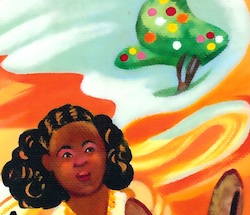It’s a seasonal phenomenon — this contrast of holidays and observance, ping-ponging between solemn and celebration. Several children’s books this spring marked Purim’s story of threat and deliverance and should be noted, even if a bit late. But celebrated here are also some new works appropriate to Pesach, Yom Ha’atzmaut, or just for fun reading together.
Prolific Eric Kimmel of Portland has won numerous children’s book awards for his holiday and folk stories. His latest retelling, The Story of Esther, A Purim Tale, is illustrated by Jill Weber in brilliant mixed media, which adds a note of humor to the serious story he tells. While following the classic tale, Kimmel slips in lessons about the cost of assimilation, about courage, and about feminism. He mentions Mordecai’s descent from Babylonian captives, which may have influenced his approach to dealing with a ruthless adversary, and shows clearly the foolishness of rulers who carelessly grant power to the unworthy and cruel.
The 1991 version of Cakes and Miracles: A Purim Tale, by Barbara Diamond Goldin, originally illustrated by Erica Weihs, has been brought back into print by Marshall Cavendish (2010). New illustrations by Jaime Zollars and a slightly shorter text enhance this story of young Hershel, whose blindness does not affect his imagination nor hamper his ability to help his widowed mother bake wonderful cookies to sell on Purim. Notes on Purim appear at the end, making this story a learning experience about the holiday, as well as about compassion and determination.
Kar-Ben Publishing has provided a Purimspiel all ready for next Purim, since we missed this one. Tilda Balsley’s The Queen Who Saved Her People, comically illustrated by Ilene Richard, is written mostly in dialogue and is intended to be used as Readers Theatre, with the text for each part printed in a different color. A bit of doggerel in the verse but an amusing concept, and isn’t that what Purim is all about?
In line with its founding as a publisher of materials for very young Jewish children, Kar-Ben’s Passover offering this season is Afikomen Mambo, a simple paperback story in rhyme which deals only with the seder, its order and the repeated refrain “I’m gonna find it” as the search goes on. Author and songwriter Rabbi Joe Black has recorded a CD of the title music, which is included.
For Yom Ha’atzmaut, two Kar-Ben titles offer very different views of children coming to Israel for the first time. In Ella’s Trip to Israel by Vivian Newman, a consultant for PJ Library, and illustrated by Akemi Gutierrez, small Ella travels to Israel with her parents and her stuffed monkey, “Kof.” As the family explores various sites and has various adventures, every possible small mishap is greeted with a casual “Eyn ba’aya. No problem.” And so it is: a small story with no problem.
However, from the opening words of Yuvi’s Candy Tree by Lesley Simpson, illustrated by Janice Lee Porter, we know Yuvi’s will be a very different journey:
“I escaped on a donkey in the dark. I wore my white dress with embroidered flowers. I rode on a donkey because I was only five. I had no shoes.”
In Ethiopia, Yuvi had dreamt of a place where candy would grow on trees. After her escape in the dark and a simply described, effectively illustrated, and harrowing trek to a Sudanese refugee camp, she and her family board a plane to Israel as part of Operation Moses. She finally arrives where sweet orange laden trees make her dreams seem to come true. “Eyn ba’aya?” No more problems? Perhaps.
On a light note, author Jacqueline Jules knows what matters to youngsters off at camp for the first time. In Picnic at Camp Shalom, charmingly illustrated by Deborah Melmon, a misunderstanding between Carly and Sara threatens to hurt Sara’s feelings and break up Carly’s new and special friendship. Happily, Carly finds a solution in time for the girls to sing Shabbat songs together while they look forward to being the most welcome people at the camp’s Sunday picnic.
Exercise is good for kids and these last two books both deal with exercise but again, in very different ways. Alef-Bet Yoga for Kids by Ruth Goldeen, with photos by Bill Goldeen, is bright and basic, with a single Hebrew letter on each page. Each letter is accompanied by a child in a variation of some classic yoga pose. For example, alef is the traditional “trikonasana,” or triangle pose.
Author Ellen Bari, a spectacular pogo stick jumper in her childhood, wrote Jumping Jenny, inspired by a day school program in Brooklyn that adopted a school in Uganda. Jenny, who often gets scolded for her incessantly hippety-hopping self, decides to put her love of jumping to good use during her school’s tzedakah fundraiser. She announces a jumpathon — 1,000 jumps. This ambitious goal is enthusiastically supported by her friends and family and her superhuman effort is marvelously brought to life in lively illustrations by Raquel Garcia Macia. Jumping Jenny sets a great example, exercising both her body and her desire to do good for others. Maybe she’ll inspire some of us to do the same.
Springing into Jewish children’s books
